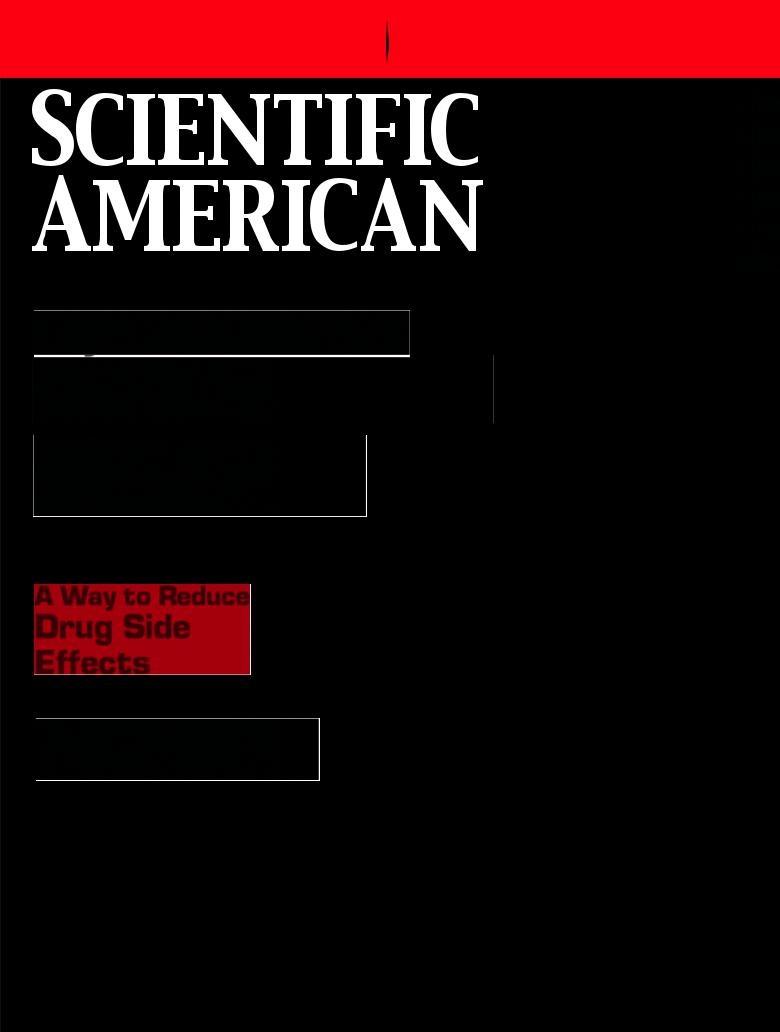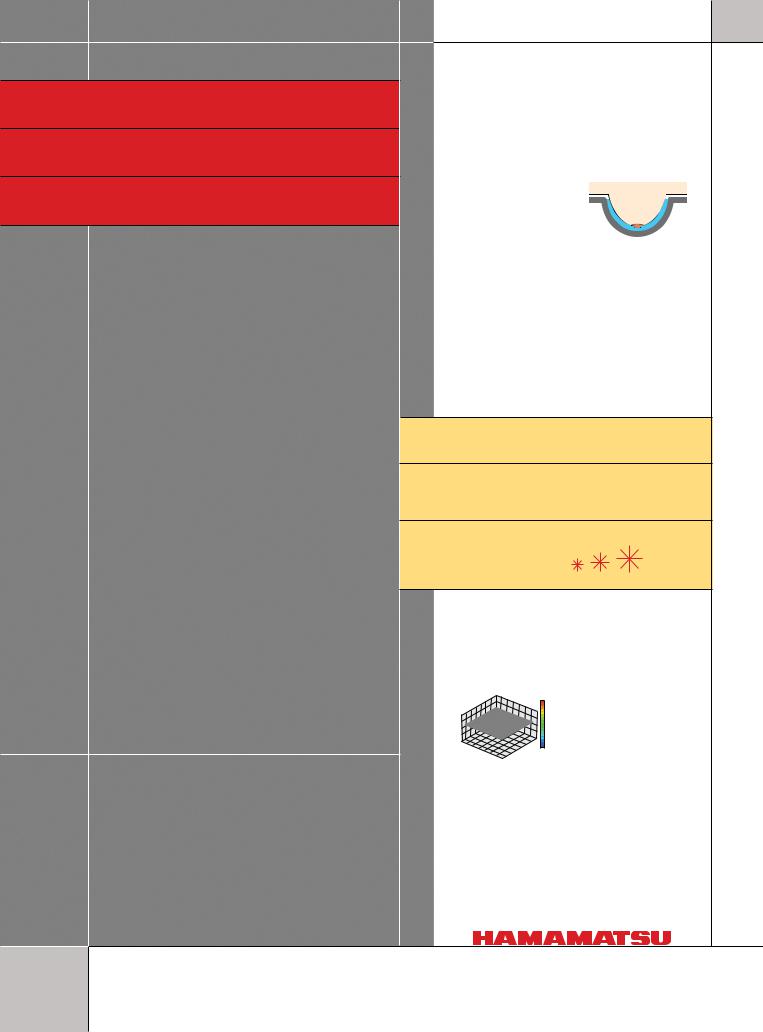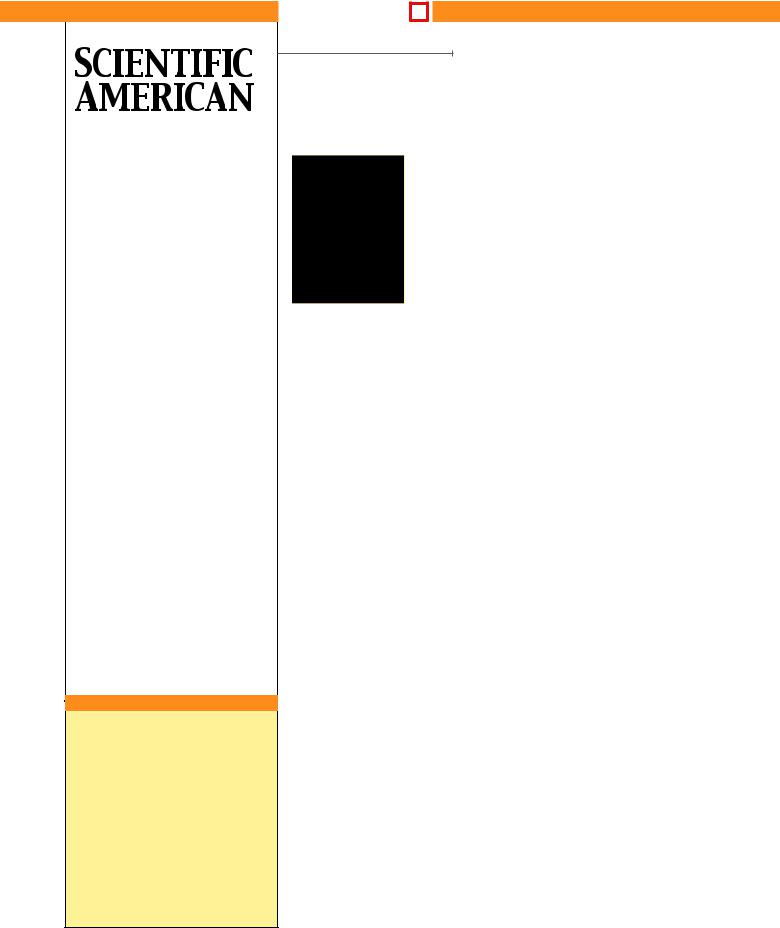

NUCLEAR WASTE |
CELIAC DISEASE INSIGHTS |
Yucca Is Dead. Now What? |
Clues to Solving Autoimmunity |
Malestrom 22-7-2009
Surprises from General Relativity:
“SWIMMING” IN SPACETIME
page 38
August 2009 |
$5.99 |
www.Scienti cAmerican.com |
Mysteries of the
Neandertals
We coexisted for thousands of years before they vanished. Here’s what happened
A Way to Reduce
Drug Side
Effects
Could Iron Reignite
Superconductors?
© 2009 SCIENTIFIC AMERICAN, INC.



FEATURES
SCIENTIFIC AMERICAN August 2009 Volume 301 Number 2
32 HUMAN EVOLUTION
Twilight of the Neandertals
By Kate Wong
For thousands of years, modern humans coexisted with Neandertals in Europe. What led to the demise of our hominid relatives? The latest research suggests several subtle factors.
PHYSICS
 38 Adventures in Curved Spacetime
38 Adventures in Curved Spacetime
By Eduardo Guéron
The possibility of “swimming” and “gliding” in curved, empty space shows that, even after
nine decades, Einstein’s theory of general relativity continues to amaze.
ENERGY POLICY
46 What Now for Nuclear Waste?
By Matthew L. Wald
Yucca Mountain was supposed to be the answer to the U.S.’s nuclear waste problem, a $9-billion hole in the desert that would be lled with radioactive detritus and sealed for a million years. That vision is now dead. Is the smartest solution to do nothing?
MEDICINE
54 Surprises from Celiac Disease
By Alessio Fasano
Study of a potentially fatal food-triggered disease has uncovered a process that may contribute
to many autoimmune disorders.
2 SCIENTIFIC AMERIC AN
38
54
46
ON THE COVER
Neandertals lived through harsh climate conditions. They made tools and even created symbolic objects. Why did they end up dying out? Image by Jean-Francois Podevin.
August 20 09
© 2009 SCIENTIFIC AMERICAN, INC.

In the future, new optical
techniques may complement
traditional mammograms...


Québec City
 MONTRÉAL
MONTRÉAL
Bar Harbor
BOSTON
Charlottetown
Sydney
Halifax
Insight




TM

MORE FEATURES
ELECTRONICS
 62 An Iron Key to High- 62 70 Temperature Superconductivity?
62 An Iron Key to High- 62 70 Temperature Superconductivity?
By Graham P. Collins
Compounds known as iron pnictides that can superconduct at 50 kelvins have reignited physicists’ quest for better high-temperature superconductors and may offer clues to unlocking a 20-year mystery.
INNOVATIONS
70 A New Kind of Drug Target
By Melinda Wenner
An emerging class of medicines works its magic by targeting unusual sites on biological molecules.
GO TO 







 .COM
.COM
IN-DEPTH REPORT:
APOLLO 11
Forty years after Neil Armstrong, Michael Collins and Buzz Aldrin reached the moon, we look at the harrowingrst lunar landing and the Apollo missions that never ew. More at www.ScientificAmerican.com/aug2009
COURTESY OF NASA
Slide Show
Top 10 New Species Discovered in 2008 From the smallest sea horse to a naturally
decaffeinated coffee tree, newly discovered species show that Earth still has plenty of surprises.
60-Second Solar Blog
What You Really Need to Install Solar Panels: A CPA If the paperwork-heavy experience of one Scientific American editor is anything to go by, a solar boom will create plenty of jobs—in accounting.
Fact or Fiction?
Should We Drink Eight Glasses of Water a Day? A popular belief holds that healthy people need liquids, even when they are not thirsty.
Slide Show
The World’s 10 Largest Renewable Energy Projects From wind and wave to sun and trash, existing
power plants are generating electricity from renewable sources on a massive scale.
60-Second Earth Podcast
Is Organic Really Better?
Does consuming organic food truly benefit both eater and environment?
Scienti cAmerican(ISSN0036-8733),publishedmonthlybyScienti cAmerican,Inc.,75VarickStreet,9thFloor,NewYork,N.Y.10013-1917.Copyright©2009byScienti c American, Inc. All rights reserved. No part of this issue may be reproduced or transmitted in any form or by any means, electronic or mechanical, including photocopying and recording for public or private use, or by any information storage or retrieval system, without the prior written permission of the publisher. Periodicals postage paid at New York, N.Y., and at additional mailing of ces. Canada Post International Publications Mail (Canadian Distribution) Sales Agreement No. 40012504. Canadian BN No. 127387652RT; QST No. Q1015332537. Publication Mail Agreement #40012504. Return undeliverable mail to Scienti c American, P.O. Box 819, Stn Main, Markham, ON L3P 8A2. Subscription rates: one year $34.97, Canada $49 USD, International $55 USD. Postmaster: Send address changes to Scienti c American, Box 3187, Harlan, Iowa 51537. Reprints available: write Reprint Department, Scienti c American, Inc., 75 Varick Street, 9th Floor, New York, N.Y. 10013-1917; (212) 451-8877; 
 fax: (212) 355-0408. Subscription inquiries: U.S. and Canada (800) 333-1199; other (515) 248-7684. Send e-mail to sacust@sciam.com Printed in U.S.A.
fax: (212) 355-0408. Subscription inquiries: U.S. and Canada (800) 333-1199; other (515) 248-7684. Send e-mail to sacust@sciam.com Printed in U.S.A.
6 SCIENTIFIC AMERIC AN |
August 20 09 |
© 2009 SCIENTIFIC AMERICAN, INC.

At the height of scientific research
Stay informed of the latest research and gain access to landmark specials, news, videos, podcasts and insights. Subscribe today and receive
30% off a 1 year personal subscription!
www.nature.com/SciAmdiscount
21292-01_Sciam filler ads Nature FP.indd 1 |
9/4/09 10:10:57 |

DEPARTMENTS
 10 From the Editor
10 From the Editor
11 Letters
1350, 100 & 150 Years Ago
14Updates
15NEWS SCAN
High hopes for high-speed rail.
White nose fungus in bats: it’s our problem.
Mistakes fuel climate-warming skeptics.
Law, medicine and a hallucinogen.
Kervaire invariant problem has a solution!
Cloaking device made simpler.
Fossil Darwinius has its 15 minutes.
Data Points: Gallons per mile as a better measure.
OPINION
28 Scientific American Perspectives
Agritech companies must stop blocking independent research into genetically modi ed crops.
29 Sustainable Developments
By Jeffrey D. Sachs
Good news on malaria control: the best price for getting antimosquito bed nets to the poor proves to be “free.”
30 Skeptic
By Michael Shermer
Shakespeare, interrupted: the anti-Stratfordian skeptics are back, and this time they have
a Supreme Court justice on their side.
31 Anti Gravity
By Steve Mirsky
Tips for being the gas hog you have the right to be.
8 SCIENTIFIC AMERIC AN
14
13
15
78 Recommendations
Celestial views. Bigfoot pursuits.
Scienti c Twitterers.
80 Ask the Experts
How do marine mammals avoid freezing to death? Do they ever feel cold?
How does bathwater well below the boiling point give off steam?
80
August 20 09
© 2009 SCIENTIFIC AMERICAN, INC.


from the editor ■
Among Our
Contributors
GRAHAM P. COLLINS
is an editor at ScientificAmerican. A native of New Zealand, he received his Ph.D. in physics from Stony Brook University in New York State. Follow his tweets at www.twitter.com/gpcollinz
ALESSIO FASANO
directs the Mucosal Biology Research Center and the Center for Celiac Research at the University of Maryland School of Medicine. He studies how intestinal permeability affects autoimmune disorders.
EDUARDO GUÉRON
is associate professor of applied mathematics at the Federal University of ABC in Brazil, where he studies gravitation, dynamical systems and
fundamental problems in general physics.
MATTHEW L. WALD
is a reporter at the NewYorkTimes, where he has covered energy topics since 1979. He has written about oil refining, electricity production, electric and hybrid automobiles, and air pollution.
KATE WONG
is an editor at ScientificAmerican. Her first book, co-authored with Donald C. Johanson, is Lucy’sLegacy:TheQuestfor HumanOrigins(Harmony, 2009). See her tweets at www.twitter.com/katewong
10 Sc i e n t i f ic A m e r ic a n
Species and Spaces
It was August 1856, three years |
frigid periods. Why did such a durable |
|
||||
before Charles Darwin would |
species die out? And in exploring their re- |
|
||||
publish On the Origin of Spe- |
grettable demise, can we get a better un- |
|
||||
cies. Workers in a lime quar- |
derstanding of what makes modern hu- |
|
||||
ry in the Neander Valley near |
mans unique? |
|
||||
Düsseldorf, Germany, unearthed a puzzle |
As science eagerly awaits the treasure |
|
||||
in a small cave: a number of ancient-look- |
trove of data from the first draft of the Ne- |
|
||||
ing bones. Thinking the bones were from |
andertal genome, due later this year, re- |
|
||||
a bear, the workers saved some of them for |
searchers have continued to mine clues |
|
||||
a local schoolteacher and amateur natu- |
from the fossil record to answer those |
|
||||
ralist, Johann Carl Fuhlrott. Fuhlrott later |
questions. In our cover story, “Twilight of |
|
||||
worked with anatomist Hermann Schaaff- |
the Neandertals,” starting on page 32, |
|
||||
hausen to study these bones. The two went |
staff writer Kate Wong relates the subtle |
|
||||
on to describe and publish the first findings |
|
|
and complex factors that |
|
||
about Neandertals, launching |
|
|
may have caused the spe- |
|
||
the field of paleoanthropol- |
|
|
cies’ ultimate collapse. |
|
||
ogy—and our enduring |
|
|
|
While we also celebrate the |
|
|
fascination with this ex- |
|
|
150th anniversary of Dar- |
|
||
tinct human relative. |
|
|
|
win’s masterwork, there is, |
|
|
Since then, we have |
|
|
|
perhaps, a larger practical |
|
|
learned a lot more about |
|
|
|
and evolutionary lesson |
|
|
this ancestor from the re- |
|
|
|
for modern society to |
|
|
mains of several hundred |
|
|
|
draw from the experi- |
|
|
additional specimens. Today |
|
|
|
ence of the Neandertals: |
|
|
Neandertals are likely the |
|
|
climate shifts that made |
|
||
best known hominid spe- |
Neandertals, our closest rela- |
|
their surroundings in- |
|
||
cies besides our own—yet |
|
creasingly inhospitable |
|
|||
tives, lived in Europe and west- |
|
|
||||
they remain mysterious |
|
may have been the ulti- |
|
|||
ern Asia for some 200,000 years. |
|
|||||
in many ways. Compet- |
mate executioner. |
|
||||
|
|
|
|
|||
ing theories place them either as an archaic |
The work of Albert Einstein occurred |
|
||||
variant of our own species, Homo sapiens, |
decades after that of Darwin, but it is no |
|
||||
with whom we interbred, or as a separate |
less remarkable in its power to transform |
|
||||
species altogether. |
|
our understanding. Some 90 years after |
|
|||
Either way, Neandertals and H. sapiens |
the publication of Einstein’s theory of gen- |
) |
||||
(Wong |
||||||
had much in common. The cranial capac- |
eral relativity, which showed that gravity |
|||||
wong |
||||||
ity of Neandertals was about as large as |
arises from spacetime being curved, physi- |
|||||
ours. They stood upright, averaging just a |
cists are still grappling with its implica- |
kate |
||||
few inches shorter than Cro-Magnons, |
tions. Eduardo Guéron explores one of |
of |
||||
);viktor deak (Neandertal); p, collins (Collins); courtesy |
||||||
with a heavier build and stronger arms |
them—the ability to “swim” through a |
|||||
and hands. They dabbled in practices— |
vacuum without needing to push on any- |
|||||
the creation of finely wrought tools and |
thing—in “Adventures in Curved Space- |
|||||
symbolic objects, including jewelry—that |
time,” beginning on page 38. Based on the |
|||||
humans do routinely, although they did |
latest research, the article offers an arm- |
|||||
not achieve our cultural heights. They co- |
chair journey into the mentally stimulating |
|||||
ethan hill (DiChristina courtesy of graham |
||||||
existed with us for thousands of years in |
landscape shaped by Einstein’s genius. ■ |
|||||
Europe before they vanished. They had |
|
|
|
|||
survived for so long, under harsh environ- |
Mariette DiChristina |
|||||
mental conditions, which included long |
|
|
acting editor in chief |
|||
Aug u st 20 0 9
© 2009 SCIENTIFIC AMERICAN, INC.

®
Established 1845
Ac ting E DITOR IN C HIE F: Mariette DiChristina MANAG ING E DITOR: Ricki L. Rusting
C HIE F NE WS E DITOR: Philip M. Yam SE nIor w rite R: Gary Stix
E DITORS: Davide Castelvecchi, Graham P. Collins, Mark Fischetti, Steve Mirsky, Michael Moyer, George Musser, Christine Soares, Kate Wong
CONTRIBUTING E DITORS: Mark Alpert, Steven Ashley, Stuart F. Brown, W. Wayt Gibbs, Marguerite Holloway, Christie Nicholson, Michelle Press, John Rennie, Michael Shermer, Sarah Simpson
A SSOC IATE E DITORS, ONLINE: David Biello,
Larry Greenemeier
ne ws Re porte rs, ONLINE: Coco Ballantyne,
John Matson
ART DIREC TOR , online: Ryan Reid
ART DIREC TOR: Edward Bell
A SSISTANT ART DIREC TOR: Jen Christiansen PHOTOGR APHY E DITOR: Monica Bradley PRODUC TION E DITOR: Richard Hunt
COPY DIREC TOR: Maria-Christina Keller COPY C Hie f: Daniel C. Schlenoff
COPY AND RESE ARC H: Michael Battaglia, Aaron Shattuck, Rachel Dvoskin, Aaron Fagan, Michelle Wright, Ann Chin
E ditorial Administr ator: Avonelle Wing SE NIOR SEC RETARY: Maya Harty
A SSOC IATE PU BLISHE R , PRODUC TION :
William Sherman
ADVERTISING PRODUCTION MANAGER:
Carl Cherebin
PRE PRESS AND QUALIT Y MANAGE R:
Silvia De Santis
PRODUCTION MANAGER: Christina Hippeli
CUSTOM PU BLISHING MANAGE R:
Madelyn Keyes-Milch
Board of Advisers
Rita R. Colwell
Distinguished Professor, University of Maryland
College Park and Johns Hopkins Bloomberg School
of Public Health
danny hillis
Co-chairman, Applied Minds
Vinod Khosla
Founder, Khosla Ventures
M. Granger Morgan
Professor and Head of Engineering and Public
Policy, Carnegie Mellon University
Lisa Randall
Professor of Physics, Harvard University
George M. Whitesides
Professor of Chemistry, Harvard University
LetterS ■
editors@SciAm.com
PTSD ■ Expanding Universe ■ Motion Sickness
“The severity of psychiatric illness fluctuates with few visible manifestations, and physicians are neither trained nor well situated for disability determination.”
—Mohinder Partap St. Louis
April 2009
■■ Quantifying Quandary
In “The Post-Traumatic Stress Trap,” David Dobbs reports on a growing number of experts who believe that post-traumatic stress disorder (PTSD) is being overdiagnosed. In support of this argument, Dobbs cites a 1990s study in which researchers asked veterans “about 19 specific types of potentially traumatic events.... Two years out, 70 percent of the veterans reported at least one traumatic event they had not mentioned a month after returning, and 24 percent reported at least three such events for the first time.” These memories are assumed to be “new,” but it may be that the subjects simply could not bring themselves to put their experiences into words so soon after those experiences occurred and that after some time they could.
John Dunn
Merrick, N.Y.
As a staff psychiatrist at the St. Louis VA Medical Center for many years (I am currently in private practice), I think concerns about diagnosis of, and disability benefits for, PTSD can be extrapolated to mental illness in general. Psychiatric disability is challenging for the Veterans Health Admin istration and the Social Security Administration because the severity of illness fluctuates with few visible manifestations, and physicians are neither trained nor well situated for disability determination—they are often conflicted between pursuing treatment that could eliminate disability and encouraging chronic disability so that their
patients can receive benefits. PTSD is a good place to start developing procedures and protocols for disability assessment.
Mohinder Partap
St. Louis
■■ Dark Energy Alternatives
“Does Dark Energy Really Exist?” by Timothy Clifton and Pedro G. Ferreira, posits that the apparent accelerated expansion of the universe could be a misconception caused by our living in the center of a giant cosmic void (in which the expansion rate would vary with position, thus making dark energy unnecessary).
The evidence for the universe’s accelerated or uneven expansion is that distant supernovae look dimmer than expected. But could this dimming be explained by a sparse but uniform haze of individual particles? The cosmic microwave background could also be caused by measuring the temperature and distribution of such a haze.
Bill Manzke
Dublin, Ohio
Another explanation for the supernovae dimming could be that light decelerates over time. If light traveled faster in the past, then it would have traveled farther than we think, making its intensity less than expected.
Joel Sanet
Miami
THE AUTHORS REPLY: What Manzke calls “haze” is usually called dust by astronomers. Lots of dust be tween supernovae and us could dim the images that
w w w. Scientific American .com |
© 2009 SCIENTIFIC AMERICAN, INC. |
SCIENTIFIC AMERIC AN 11 |
|
|

letterS ■
we measure with our telescopes. But this would mean that distant supernovae would consistently look dim mer as we looked farther and farther away. We can use this as a test because if we look sufficiently far back, theuniversewasnotaccelerating(or,alternatively,the supernovaewerenotinthevoid),sotherewillnotbe the systematic dimming that a haze would produce.
EFFECTS ATTRIBUTED to dark energy could instead be caused by the uneven expansion of space.
Further,iftherewerelotsofabsorptionfromdust,this would change the spectrum of the light we receive. As tronomers check to see if this is the case.
Hot dust causing the cosmic microwave background isaninterestingthought,butitisunlikelytobetrue.The microwave background radiation is almost perfectly evenly distributed across the sky, and its properties show it was emitted from something in perfect thermal equilibrium.Ifitwerebeingemittedfromdust,itwould have a very different spectrum and would be very un likely to be so perfectly evenly distributed.
RegardingSanet’sletter,thespeedoflighthaving a constant value is at the heart of relativity and has been built into modern quantum theories of the funda mentalforces.Nevertheless,therearesomeresearch ers who have been looking into the possibility that the speed of light could change on cosmological time scales.Thiswouldhaveotherimplicationsforcosmo logical problems and has been used by some to try to explain why the universe looks so smooth on very large scales.Butitisverydifficulttocreateatheoryinwhich the speed of light can vary. For now, there is a lot of evidence in support of conventional relativity, and so that is the favored theory.
■■ Balancing Fact?
“Finding Balance,” by Brendan Borrell [News Scan], reports on evidence for the
12 Sc ien t ific Americ an
theory, posited by Thomas Stoffregen of the University of Minnesota, that motion sickness is caused by poor posture control. Borrell states that Stoffregen hopes to further test his theory by having subjects float in water, where “the human body becomes passively stable, and postural control is no longer an issue,” making motion sickness “impossible.” I am a frequent scuba diver and have been diving with many who get sick while floating on the surface in rough seas. Less common but still frequent are people who get seasick while underwater in mostly shallow depths of around 25 feet when there is “surge” (back-and-forth water movement).
Chris Albertson
Redondo Beach, Calif.
STOFFREGEN REPLIES: Motionsicknesswhilefloat ing on the water is not surprising, as people will try to hold their head above the water. When the head is held out of the water, it is not passively stable.
More interesting is people having motion sickness while fully submerged in shallow water that is mov ing. Moving water could lead to unstable control of the body, especially if people are trying to maintain visual contact with something. In this case, water motion would tend to push the body around, desta bilizing the attempted visual fixation.
My proposal for testing our theory is to place peo ple (fully submerged) at neutral buoyancy in calm and stationary water and to show them visual motion stimuli representing things that are effective at mak ing people sick on land. If people get sick underwater but exhibit instability before becoming sick, we would have a confirmation of the theory, together with the disappointing realization that water immer sion cannot permit “hard” theory testing after all.
CLARIFICATION “The Post-Traumatic Stress Trap,” by David Dobbs, describes Gerald M. Rosen of the University of Washington as a psychiatrist. He is a psychologist.
Letters to the Editor
Scientific American
75 Varick Street, 9th Floor New York, NY 10013-1917 or editors@SciAm.com
Letters may be edited for length and clarity. We regret that we cannot answer each one.
Post a comment on any article instantly at
www.ScientificAmerican.com/ sciammag
®
Established 1845
p R E SID E N T: Steven Inchcoombe
Manag ing Direc tor , Inte rnational:
Kevin Hause
VIC E PRESIDE NT, ope r ations and Administr ation : Frances Newburg
manag ing DIREC TOR , consu me r marketing:
Christian Dorbandt
a ssoc iate DIREC TOR , consu me r marketing:
Anne Marie O’Keefe
Se nior Marketing Manage r /Rete ntion :
Catherine Bussey
Senior Marketing Manager/Acquisition:
Patricia Elliott
VIC E PRESIDE NT AND PU BLISHE R:
Bruce Brandfon
vic e preside nt, marketing and sales
de ve lopme nt: Michael Voss
DIREC TOR , global me dia solutions:
Jeremy A. Abbate
SALES DE VE LOPME NT MANAGE R:
David Tirpack
SALES RE PRESE NTATIVES: Jeffrey Crennan,
Thomas Nolan, Stan Schmidt
PROMOTION MANAGE R: Diane Schube
Vic e preside nt, financ e , and
GE NE R AL MANAGE R: Michael Florek
BUSINESS MANAGE R: Marie Maher
DIREC TOR , ANC ILL ARY PRODUC TS: Diane McGarvey
How to Contact Us
s u b sc ri p t ions
For new subscriptions, renewals, gifts, payments, and changes of address: U.S. and Canada, 800-333-1199; outside North America, 515-248-7684 or www.ScientificAmerican.com
r e pri n ts
To order reprints of articles: Reprint Department, Scientific American, 75 Varick Street, 9th Floor, New York, NY 10013-1917; 212-451-8877,
fax: 212-355-0408; reprints@SciAm.com
pe r missions
For permission to copy or reuse material: Permissions Department, Scientific American, 75 Varick Street, 9th Floor, New York, NY 10013-1917; 212-451-8877;
www.ScientificAmerican.com/permissions or 212-451-8546 for procedures. Please allow three to six weeks for processing.
adve rtising
www.ScientificAmerican.com has electronic contact information for sales representatives of Scientific American in all regions of the U.S. and in other countries.
August 20 09
DON DIXON
© 2009 SCIENTIFIC AMERICAN, INC.

50, 100 & 150 Years Ago ■
Innovation and discovery as chronicled in Scientific American
SCIENTIFIC AMERICAN, VOL. 201, NO. 2; AUGUST 1959
 Making Waves ■ Flying into History ■ Looting Gold
Making Waves ■ Flying into History ■ Looting Gold
Compiled by Daniel C. Schlenoff
AUGUST 1959 |
|
will be the first to pick up the returning |
BLÉRIOT’S TRIUMPH—“The |
dramatic flight |
||||
WAVES—“Man |
would like to learn the |
voyager from far-distant shores.” |
of Louis Blériot across the English Chan |
|||||
ways of the waves merely by watching |
|
nel has set a milestone of progress which |
||||||
them, but he cannot, because they set him |
PROTO-TELEVISION—“Mr . Ernest Ruhmer, |
must forever be memorable. No one, sure- |
||||||
dreaming. Try to count a hundred waves |
of Berlin, well known for his inventions in |
ly, would be so unjust as to belittle this |
||||||
sometime and see. The questions asked by |
the field of wireless telephony and telegra- |
great performance by reference to earlier |
||||||
the wave watchers are nonetheless being |
phy, has succeeded in perfecting what is |
and longer flights over the land. In point |
||||||
answered by intensive |
|
|
of risk and daring, that |
|||||
studies of the sea and by |
|
|
bold, early morning dash |
|||||
the examination of waves |
|
|
across the Channel stands |
|||||
in large experimental |
|
|
in a class by itself. The fact |
|||||
tanks. The new knowl- |
|
|
that the first flying ma |
|||||
edge has made it possible |
|
|
chine to cross the Chan |
|||||
to measure the power and |
|
|
nel was of a monoplane |
|||||
to forecast the actions of |
|
|
design has raised |
the |
||||
waves for the welfare of |
|
|
prestige of that type.” |
|||||
those who live and work |
|
|
|
|
|
|||
on the sea and along its |
|
|
AUGUST 1859 |
|||||
shores. In the large tank |
|
|
||||||
at the Stevens Institute of |
|
|
GOLD GRAVES—“The |
ab- |
||||
Technology in Hoboken, |
|
|
original inhabitants of |
|||||
New Jersey, artificial ir- |
|
|
Central America, who |
|||||
regular waves approach |
|
|
occupied it at its discov- |
|||||
the variability of those in |
|
|
ery by the white men of |
|||||
the deep ocean. In our |
|
|
the East, had a custom of |
|||||
photograph, |
the ship |
|
|
burying their dead sur- |
||||
model proceeds under its |
|
|
rounded with gold. We |
|||||
own power; its motions |
|
|
learn that new discover- |
|||||
are recorded by means of |
|
|
ies have been made at Da- |
|||||
the apparatus above it.” |
|
|
|
vid, Chiriqui [in Pana- |
||||
|
|
|
|
|
ma]. There is now a great |
|||
AUGUST 1909 |
SHIP MODEL, five feet long, undergoes tests in a wave tank, 1959 |
emigration to these novel |
||||||
‘diggins,’ and reports say |
||||||||
|
|
|
||||||
CELESTIAL VISITOR—“The |
approach of Hal- |
probably the first demonstration appara- |
gold is very profuse. But we are inclined to |
|||||
ley’s comet is the most important astro- |
tus which may be said actually to solve the |
think that after the country has been so |
||||||
nomical event of the years 1909 and 1910. |
problem of tele-vision. The writer has had |
well ransacked in the sixteenth century, |
||||||
Every seventy-five or seventy-six years this |
an opportunity of inspecting this curious |
there cannot be so much as rumor would |
||||||
remarkable body completes its far-stretch- |
machine immediately before its being sent |
have us believe. The images are cast and |
||||||
ing and extremely elliptical orbit around |
to Brussels, in order there to be demon- |
polished, and exhibit much ingenuity in |
||||||
the sun. It was last seen at the Cape Obser- |
strated before the promoters of the Uni- |
the modeling. The people by whom such |
||||||
vatory in May, 1836, but although it van- |
versal Exhibition planned for next year. In |
objects were made must have been consid- |
||||||
ished from the sight of men, its onward |
fact, a complete and definite tele-vision |
erably advanced in civilization. The study |
||||||
track through space was known with as |
apparatus, costing the trifling sum of one |
of American antiquities will doubtless be |
||||||
great accuracy, relatively, as sailors know |
and a quarter million dollars, is to be the |
advanced by the discovery of these re- |
||||||
the way of a ship over the trackless deep. |
clou of this exposition.” |
markable images, and we think they |
||||||
No small emulation is being witnessed be- |
The entire article is available at |
should be preserved, instead of being |
||||||
tween those observatories endowed with |
thrown into the refiner’s melting-pot, like |
|||||||
large telescopes, as to which one of them |
www.ScientificAmerican.com/aug2009 |
an unfashioned nugget or scaly dust.” |
|
|||||
w w w. Scientific American .com |
© 2009 SCIENTIFIC AMERICAN, INC. |
|
SC IE NTIFIC AMERIC AN 13 |
|||||
|
|
|
|
|
|
|
||
